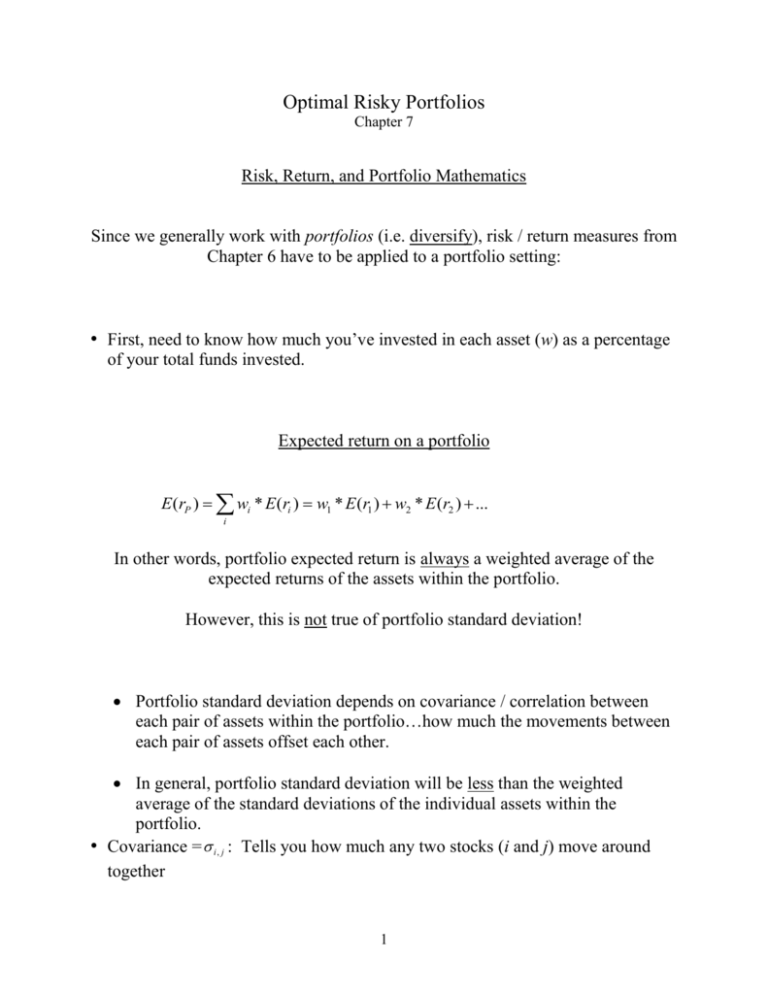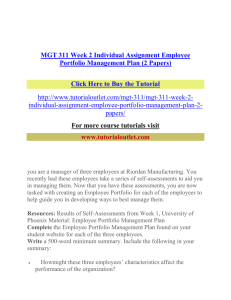Portfolio Selection with a Risk
advertisement

Optimal Risky Portfolios Chapter 7 Risk, Return, and Portfolio Mathematics Since we generally work with portfolios (i.e. diversify), risk / return measures from Chapter 6 have to be applied to a portfolio setting: • First, need to know how much you’ve invested in each asset (w) as a percentage of your total funds invested. Expected return on a portfolio E (rP ) wi * E (ri ) w1 * E (r1 ) w2 * E (r2 ) ... i In other words, portfolio expected return is always a weighted average of the expected returns of the assets within the portfolio. However, this is not true of portfolio standard deviation! Portfolio standard deviation depends on covariance / correlation between each pair of assets within the portfolio…how much the movements between each pair of assets offset each other. In general, portfolio standard deviation will be less than the weighted average of the standard deviations of the individual assets within the portfolio. • Covariance = i, j : Tells you how much any two stocks (i and j) move around together 1 Cov(r1, r2 ) 1, 2 Pr( s)[ r1 ( s) E (r1 )][ r2 ( s) E (r2 )] s Prob. 1 2 .3 .5 .2 .2 .1 - .05 .1 .2 .4 Great OK Bad 1, 2 .3 * (.2 .1) * (.1 .21) .5 * (.1 .1) * (.2 .21) .2 * (.05 .1) * (.4 .21) = -.0033 + 0 + -.0057 = -.009 Correlation between Two Assets The correlation coefficient “standardizes” covariance – puts it into a form that tells you how much two assets actually move together. Correlation coefficients are scaled between –1 and +1: ij ij i j .009 = -.995 (.0866)(.1044) = Finally, we can use covariance to tell how risky the entire portfolio is … Variance of a portfolio N N wi w j i , j 2 P i 1 j 1 If N=2, w w 2w1w2 1, 2 If N=3, P2 w12 12 w22 22 w32 32 2w1 w2 1, 2 2w1 w3 1,3 2w2 w3 2,3 2 P 2 1 2 1 2 2 2 2 Last step: Take square root of variance to get standard deviation. 2 Why do we focus on mean and standard deviation to describe a portfolio? If asset returns are normally distributed, mean and standard deviation define all you need to know about the most likely return and the likelihood that you will end up with a return less than (greater than) the most likely return (mean). Estimating expected returns, variances, and covariances from Past Returns • Assume returns are drawn from the same distribution over time • Use past returns to estimate the mean, the variance of each asset, and the covariance between each pair of assets • Note: assume all past returns have equal probability - why?? 3 Why are combinations of two risky assets concave? Depends on extent of correlation between assets making up the portfolio … Two asset case: -Assume E(r2 ) E(r1 ) , 2 1 E(rP) All Asset 2 1, 2 1.0 1, 2 1.0 Various weightings 1, 2 1.0 of the two assets result in these portfolios. All Asset 1 Observations: Perfect positive correlation: No benefit from diversification (portfolio standard deviation = ?) Perfect negative correlation: Zero-risk portfolio possible Portfolio Variance and Diversification with numbers 2 2 2 2 2 We know that P w1 1 w2 2 2w1w21, 2 And since 1, 2 1, 2 1 2 (from definition of correlation), 4 P 2 2 2 2 2 Then P w1 1 w2 2 2w1w2 1, 21 2 Diversification in Action: Suppose that: 12 22 0.05 and w1 w2 0.50 P2 .502 (0.05) .502 (0.05) 2(.50)(.50) 1,2 = .025 + .05 .05 1, 2 (.025) Result: Variance of portfolio is less than the variance of each individual asset (.05) as long as Ex: If 1, 2 < 1 (i.e. not perfectly correlated). 1, 2 = 0, P2 = .025 < var(Asset 1) or var(Asset 2) 5 Now, consider a portfolio of many stocks: n 2 P i 1 n w w j 1 i j n i, j n i 1 2 i Suppose all stocks have SD’s = .40 and Num securities 1 2 8 32 128 510 n w wi w j i , j 2 i i 1 j 1 i , j 0 (uncorrelated): SD(portfolio) 40 % 28.3 14.1 10.0 3.5 1.8 Combining stocks together can make portfolio risk really small, if the stocks are uncorrelated. Intuitive Interpretation of Covariance A “marginal” variance: Measures what happens (to the portfolio’s overall variance) when we add a tiny bit more weight to one of the stocks in the portfolio At the margin, the covariance of stock with the rest of the portfolio is the only relevant influence on resulting variance of portfolio. A little bit more of stock j to the portfolio increases (decreases) the portfolio’s variance if stock j is positively (negatively) correlated with the portfolio Bottom line to Part B: The more risky assets are not correlated, the greater the benefits from diversification. 6 Optimal Risky Portfolios with two risky assets and a risk-free asset Given two risky assets, we know that various portfolios curve to the left in an expected return/standard deviation graph if they are less than perfectly correlated We also know that combining any risky asset (or portfolio) with a risk-free asset results in a straight line (the CAL) in the same graph. Q: If you can combine the risk-free asset together with any combination of the two risky assets, which combination of the two risky assets do you (and all other investors) choose? Answer: The tangency portfolio (P*) -- this portfolio has the steepest CAL. CAL (P*) E(r) A less risk averse investor chooses this mix of P* and the risk-free asset (is a borrower) P* Without a risk-free asset, a less risk averse investor chooses this portfolio Without a risk-free asset, a more risk averse investor might choose this portfolio A more risk averse investor would instead choose this mix of P* and the risk-free asset (is a lender) rF P Note that investors of all types are better off mixing the risky portfolio P* with the risk-free asset (more risk-averse investors lend, less risk-averse investors borrow.) Without the risk-free asset, each investor type chooses a unique risky portfolio along the (old) efficient frontier. With the risk-free asset, all investors choose the same risky portfolio P* in combination with the risk-free asset on the (new efficient frontier) CAL. This results in higher utility for both types (they can reach a higher indifference curve.) 7 Q: Is there a formula for the weights of the global minimum variance formula? Answer: Yes … if you have two risky assets, 1 & 2… wMin (1) 22 Cov(r1 , r2 ) , 12 22 2Cov(r1 , r2 ) so wMin (2) 1 wMin (1) Q: What are the weights of the optimal risky portfolio (P) ? Answer: Formula 7.13 on p. 220. Final Q: Once you know how to put together the optimal portfolio P, how do you allocate your money between P and rF ? Answer: Use the formula from Part A above: y* E (rP ) r f A P2 8 The Markowitz Portfolio Selection Model Given a fixed number of risky assets, you can form lots of portfolios Some of these portfolios form the minimum-variance frontier Of the minimum-variance frontier portfolios, efficient portfolios offer: – – maximum return for a given amount of risk, and minimum risk for a given return. In general, points along the efficient frontier have to satisfy the two following conditions: P subject to some target E(r) Highest E(r) subject to some target P Lowest and Efficient Frontier E(r) Global minimum variance portfolio Minimum variance frontier P 9 All of these risky portfolios combine with the risk-free asset in straight lines … E(r) CAL (optimal risky portfolio) Efficient Frontier Some risky asset P* Global minimum variance portfolio rF P Result: One portfolio (P) dominates all of the other efficient portfolio on the efficient set - Investors who choose combinations of P and the risk-free asset get the highest return for a given level of risk, compared to all other risky portfolios - In other words, all investors choose from points along the CAL passing through portfolio P. Separation Property: Risky portfolio selection is separate from how funds are allocated between risky and risk-free assets 10 Portfolio Optimization in Practice Typical asset classes: Asset Allocation Matrix: Cash/Cash Equivalent Equities Fixed Income Mixed Cap Mutual Other Classes Funds Cash Dow Industrial Investment Grade Corporate Bonds Balanced REITs Equity, Mortgage and Hybrid Money Market Funds S&P 500 Government/ Agency Bonds Growth Other Alternative Classes Treasury Bills NASDAQ 100 Treasury Bonds Income Natural Resources Certificate of Deposits (CDs) Russell 2000 High Yield Corporate Bonds Growth & Income Hard Assets: Commodities Precious Metals Canadian Dollars S&P Utilities Municipal Bonds International Equities Hedge Funds Japanese Yens Wilshire 5000 Mortgage backed Securities Sector Weightings Hybrid Fixed Income & Equity Strategies World Money Market Funds International Equities International Bonds Total Return Convertibles ....................................................................................................................................................... ........................... Typically, do not use utility analysis to identify optimal portfolio (P*) (where you need to know the exact form of the utility function and the distribution of returns): Maximize return for a given level of risk - E.g. suppose your current portfolio is made up of 60% US stock, 40% US bonds. Assume the expected return of this portfolio is 12.4% with a standard deviation of 14.5%. Moving up to the efficient frontier (involving a more diversified portfolio) results in the same risk but an expected return of 14.7%. 11 Maximize geometric mean - E.g. suppose you have a 20-year holding period horizon. Your “ideal” portfolio has the highest expected value of terminal wealth. This is the portfolio with the highest geometric return, which results in the following: (1) Has the highest probability of reaching, or exceeding, any given wealth level in the shortest possible time, and (2) Has the highest probability of exceeding any given wealth level over any given period of time. This criteria *usually* results in a portfolio that is on the efficient set (surprising?) Risk tolerance - This technique involves maximizing a linear function of expected return and variance scaled by risk tolerance, e.g. Expected Return - Variance Risk Tolerance This results in a “maximized utility” portfolio (similar to indifference curve analysis) Safety first – concentrate on bad outcomes - Roy (1952) argued that investors should pick portfolios in order to maximize the likelihood of getting above some threshold minimum return. Once you have identified the efficient frontier, draw a straight line from this minimum return tangent to the efficient frontier. Lower thresholds result in optimal portfolios with less return / risk, etc. Minimize Prob(RP RL ) , where RP is the return on the portfolio and RL is the minimum threshold return. 12 What if you can lend, but not borrow? E(r) P* for less risk averse investor P* for more risk averse investor rF More risk averse investor’s actual allocation - More risk averse investors choose points along the CAL extending to P, while less risk averse investors choose risky portfolios along the right side of the (old) efficient frontier 13 What if there are different lending and borrowing rates? • Two tangency points (get kinked investment opportunity set): E(r) Investment Opportunity Set P2 P1 rF(B) Tangency Points rF(L) C If face borrowing rate, lending portion of CAL not applicable Lenders (more risk averse) choose P1, borrowers (less risk averse) choose P2. Q: What if you are “moderately” risk averse ? 14






